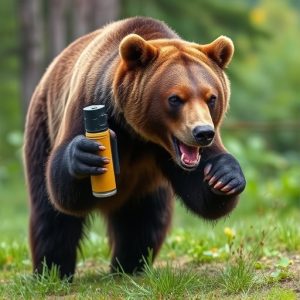Maximizing Bear Spray Efficacy: Capsaicin Concentration & Choosing Right Repellent
Bear spray effectiveness hinges on its capsaicin concentration, with 2% or higher recommended for de…….
Bear spray effectiveness hinges on its capsaicin concentration, with 2% or higher recommended for deterring aggressive bear behavior. Higher capsaicin levels enhance disorientation, offering better protection. Choosing the right spray involves considering activity type, experience level, and local bear species, between water-based (1.5%-2%) and oil-based (3%-4%) formulas. Safe handling includes storage in cool, dry places, expiration checks, child/pet prevention, and practice targeting techniques for optimal performance during encounters.
“Bearing the brunt of a predator attack can be terrifying. Enter bear spray, a powerful tool for self-defense. This article equips you with essential knowledge on using bear spray effectively. We’ll demystify the key component, capsaicin concentration, and how it dictates its efficacy. From understanding different types to safe handling practices, learn what goes into choosing the right bear repellent. Discover expert tips to maximize your protection against potential threats, focusing on the science behind capsaicin concentration in bear repellents.”
- Understanding Bear Spray: The Basics
- How Capsaicin Concentration Affects Efficacy
- Choosing the Right Bear Repellent for Your Needs
- Safe Use and Storage Practices
Understanding Bear Spray: The Basics
Bear spray, also known as bear repellent, is a powerful tool designed to protect individuals from potential bear encounters in their natural habitats. It’s more than just a spray; it’s a defense mechanism that utilizes capsaicin, the active ingredient found in chili peppers, to deter bears. The key to its effectiveness lies in the capsaicin concentration—the higher the concentration, the greater the likelihood of scaring off an aggressive bear.
When considering bear spray, understanding the capsaicin concentration is crucial. Products vary, but typically, a spray with a 2% or higher capsaicin level is recommended for bear repellent. This concentration is enough to cause irritation and discomfort in bears, encouraging them to retreat. The spray creates a temporary yet effective barrier, providing hikers and campers with valuable time to escape or defend themselves should a bear approach.
How Capsaicin Concentration Affects Efficacy
The effectiveness of bear spray as a defense mechanism depends heavily on the capsaicin concentration. Capsaicin, the active ingredient in pepper spray, is what causes the stinging sensation and disorienting effects. A higher capsaicin concentration means stronger irritancy, which can be crucial when facing an aggressive predator like a bear. The recommended range for bear repellent sprays is typically between 2% to 4% capsaicin, as anything lower may not provide sufficient protection.
Manufacturers often advertise their products based on capsaicin content, highlighting higher concentrations as more effective against bears. However, it’s important to remember that even a small amount of capsaicin can be detrimental to a bear’s senses, temporarily blinding and disorienting them enough for you to escape. This makes understanding the capsaicin concentration an essential factor in choosing the right bear spray for your needs.
Choosing the Right Bear Repellent for Your Needs
When considering bear spray as a defense against predators, it’s crucial to choose the right repellent that matches your specific needs. The effectiveness of bear spray lies in its capsaicin concentration – the higher the concentration, the better the protection. Look for products with at least 1.5% capsaicin, which is recommended by experts for reliable deterrence. Additionally, consider factors like intended use (hiking, camping, hunting), your level of experience, and the types of bears you’re likely to encounter in your region.
Matching your bear spray to your needs ensures optimal performance when you need it most. Water-based repellents might be lighter but could wash off easily, while oil-based options offer longer lasting protection but are heavier. Always read product labels carefully and follow instructions for proper application. Choosing the right repellent is a vital step in enhancing your safety during outdoor activities in bear country.
Safe Use and Storage Practices
When using bear spray as a defense, it’s paramount to understand safe handling practices. Always inspect the product for any signs of damage or expiration before each use. Store bear repellent in a cool, dry place away from direct sunlight and heat sources, as extreme temperatures can affect its potency. Keep out of reach of children and pets, securing it in a locked cabinet if possible. Familiarize yourself with the spray’s operating mechanism and practice targeting techniques in safe environments to ensure accurate deployment when needed.
The capsaicin concentration in bear repellent plays a crucial role in its effectiveness. Products with higher concentrations (typically ranging from 2% to 4%) offer greater potency, providing more time for you to retreat safely. Lower concentrations still serve as deterrents but may require closer proximity to the predator. Check product labels carefully and choose a spray tailored to the specific wildlife you’re facing in your region. Regularly test and replace your bear spray according to manufacturer recommendations to maintain its viability.
Bear spray, primarily composed of capsaicin, is an effective defense mechanism against predators. Understanding the capsaicin concentration ensures optimal protection during encounters. Choosing the right bear repellent tailored to your specific needs is crucial for safety. Always follow safe use and storage practices to maintain its efficacy. Remember, proper preparation and knowledge about capsaicin concentration in bear repellents can significantly enhance your survival chances in potential predator interactions.


